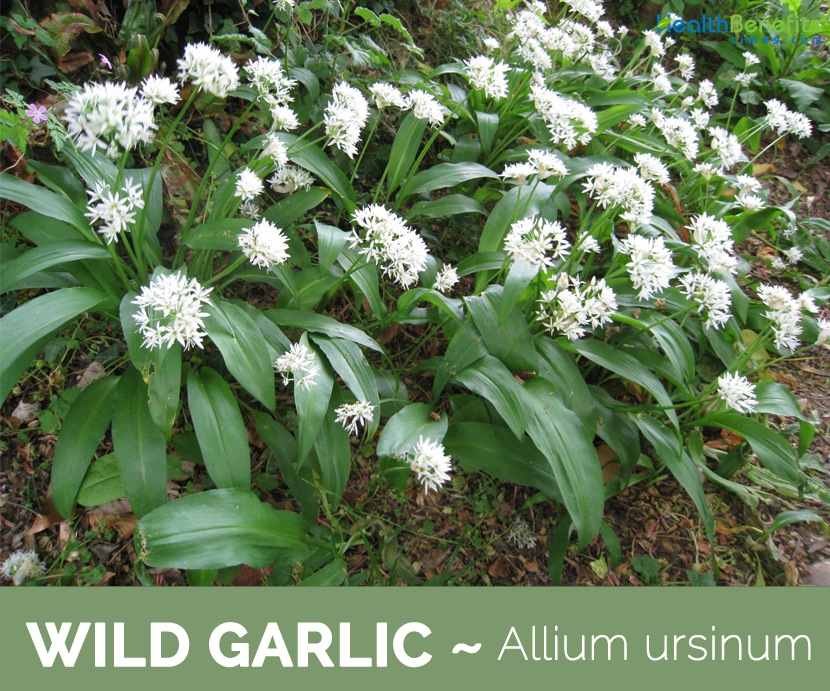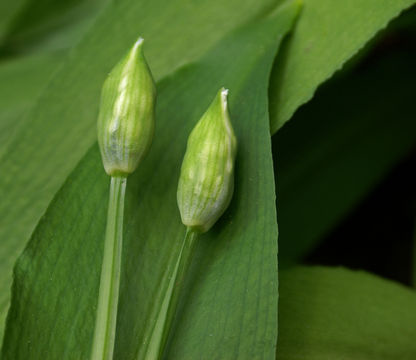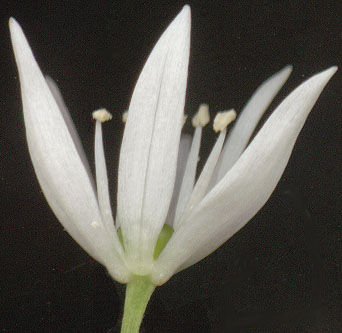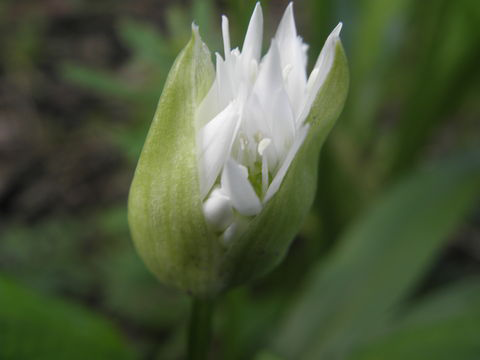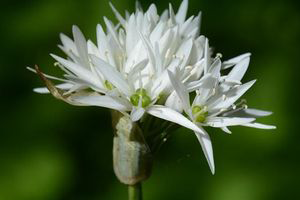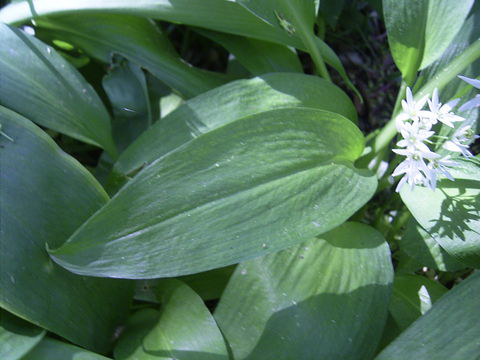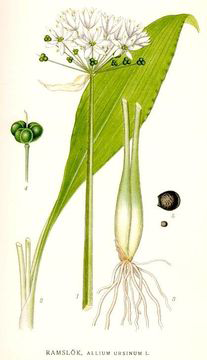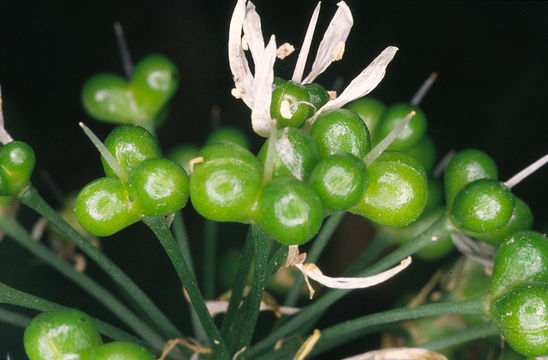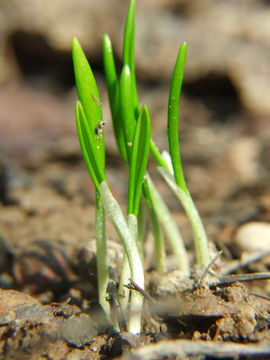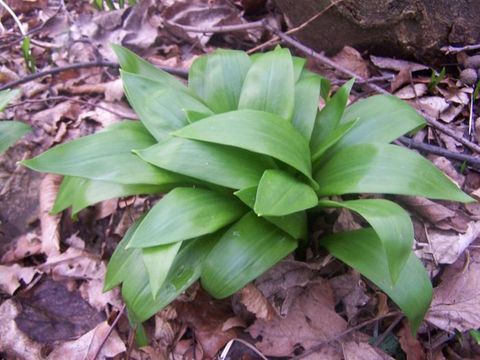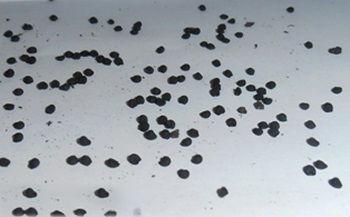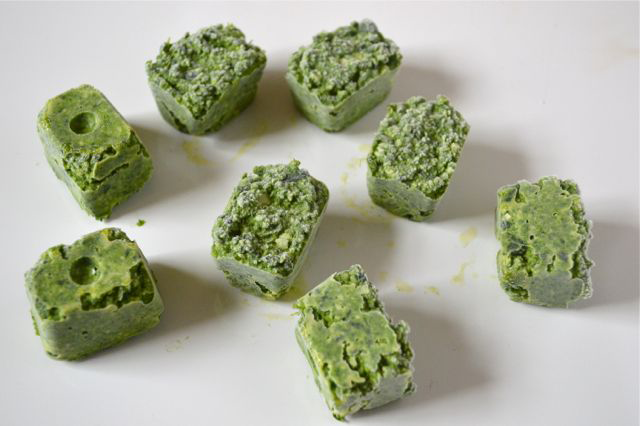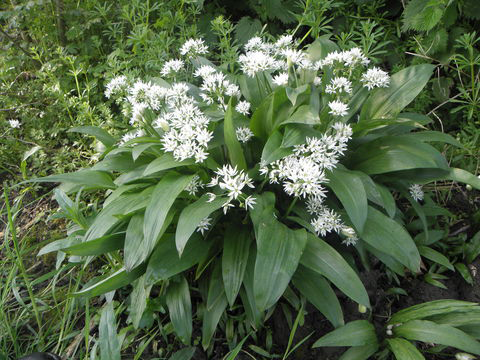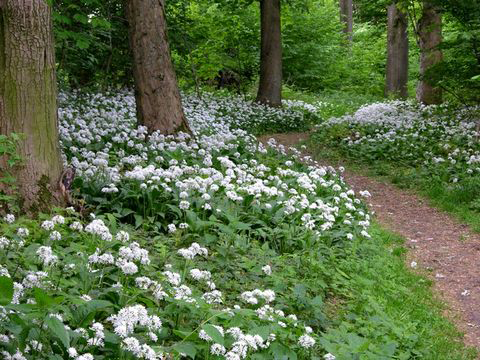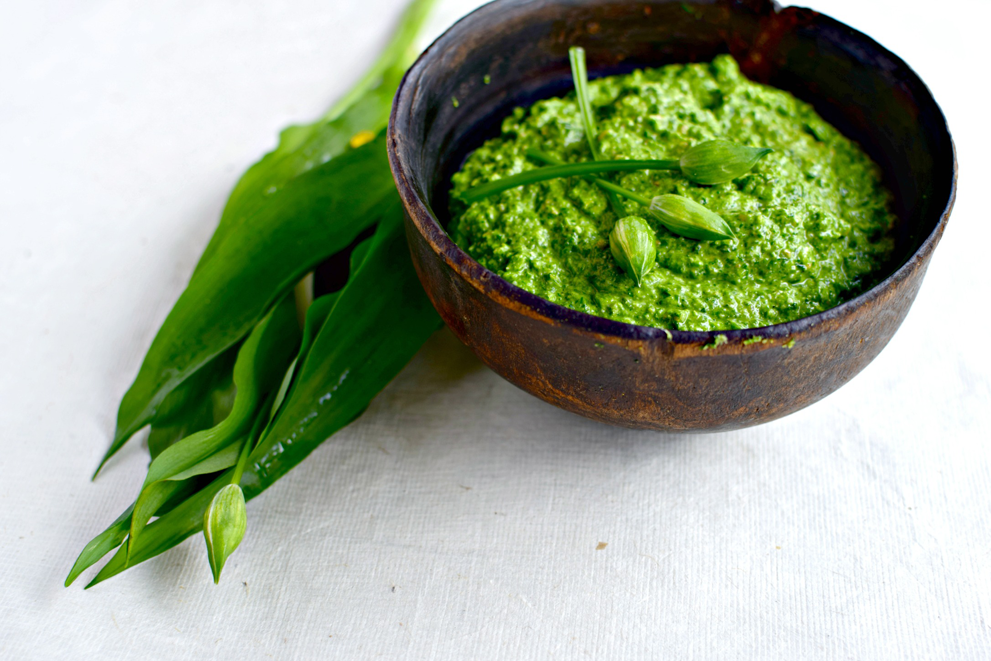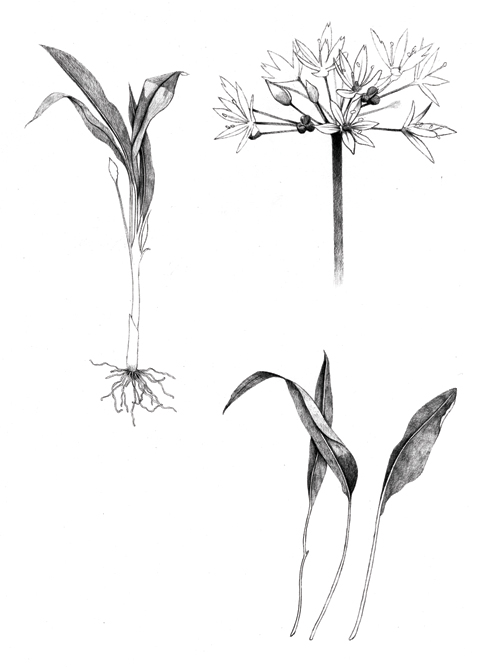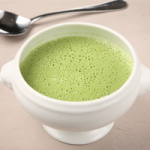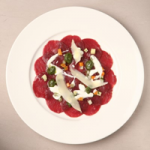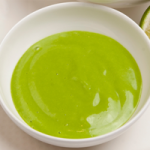Plant Description
Wild Garlic is a monocot bulbous, perennial herbaceous plant that grows about 12 feet (3.7 m) tall. The plant is found growing in moist deciduous forests, valleys and along streams and normally favors moist soils, preferring slightly acidic conditions. The plant has upright and thin bulb that is white or yellow in color. The plant produces small rounded bulbs on branched rhizomes. The stem is triangular in shape and the leaves are similar to those of the lily of the valley. Every year, leaves appear in late winter, flowers bloom in spring, and seeds mature by mid-summer at which point the plants die back and go dormant until the following late winter.
Leaves
The plant consists of bright green, entire, elliptical leaves that are long, pointed and oval in shape with untoothed margins up to 25 cm long x 7 cm wide with a petiole up to 20 cm long. Leaves grow from the plant base, from the bulb of the plant itself. If bruised or crushed, the foliage emits a strong onion/garlic-like aroma. Wild garlic plants typically have 2 or 3 leaves, but older, well-established plants may have more.
Flower & Fruit
The inflorescence is an umbel of six to 20 white flowers only, lacking the bulbils. The flowers are star-like with six white tepals, about 16–20 mm in diameter, with stamens shorter than the perianth. Six petals make up a flower, with around 25 of these forming the rounded shaped flower cluster. Flowers are on leafless stalks. Umbellate garlic-scented flowers produce capsules which has black seeds inside.
Leaves and flowers may be eaten raw in the form of salads or cooked as an addition to soups, sauces or stews. Leaf flavor begins to drop as the flowers start to bloom. Underground bulbs can also be eaten raw or cooked.
History
Bear’s garlic (Wild Garlic) boasts a very long history of use. The 1st-century Greek botanist Pedanius Dioscorides stated it in his five-volume herbal encyclopedia, describing its effectiveness for the cleansing and detoxification of the body. During the middle Ages, King Charlemagne of present-day France classified the plant in his Capitulare de Villis imperialibis, a guide that highlighted the medicinal properties of common herbs.
In 1992, bear’s garlic was named Plant of the Year by the Society for the Protection and Investigation of European Flora. Although easily overshadowed by its more lucrative relatives, bear’s garlic still holds the same wonderful health benefits that initially earned it the esteemed title. Today it is found in several parts of the world due to its wonderful health promoting benefits and amazing addition to different cuisines.
Health benefits of Wild Garlic
Medicinally speaking, there are several remarkable uses for wild garlic, including in the treatment of high blood pressure, high cholesterol, stomach upset, and chronic disease, among others. This particular garlic can be used internally or topically as an herbal supplement or added to poultices and other home remedies. Listed below are some of the well-known health benefits of using wild garlic in your everyday routine
1. Treats Chronic Diseases
Active ingredients in wild garlic have the ability to neutralize free radical activity before it can lead to cellular mutation and oxidative stress in different parts of the body. This can help to lower your risk of cancer and other chronic diseases, such as heart disease or arthritis.(1)
2. Improves Heart Health
Garlic is known to have a soothing effect on high blood pressure, which can lessen your risk of atherosclerosis, heart attacks, and strokes. Additionally, wild garlic is able to lower overall cholesterol levels, keeping your heart in good shape as you age. (2)
3. Treats Stomach Issues
Antibacterial and anti-fungal compounds found in this wilder form of garlic can help to re-balance the bacterial flora in your gut, which helps to calm inflammation, bloating, cramping, constipation, and other stomach issues you may be handling. (3)
4. Antibacterial effect
It was already shown that garlic has strong antibacterial effects. But the effect is to feel really strongly, take fresh, rough leaves. Wild garlic helps to cleanse the stomach-intestinal system of microbes and bacteria. So, its regular consumption can be used as prophylaxis against serious illnesses, including cancer.
5. High cholesterol and blood pressure
Due to the presence of some important minerals Wild garlic leaves still young is recommended to people who suffer from high cholesterol level and triglycerides in their blood, as well as high blood pressure. This plant has a beneficial effect to the arteries and it can also prevent atherosclerosis.
6. Inflammations and infections
Consumption of fresh wild garlic has a beneficial effect on the parasites in the intestines. It helps to prevent the intestines from irritations and also protects the organism from colds and flu. It helps in the treatment of bronchitis, because it clears the airways, relieves breathing and decreases cough.
7. Good for the skin
Wild Garlic in the form of bath is ideal for everyone who suffers from problematic skin, inflammatory processes on the skin, skin irritation, eczema and dermatitis.
8. Decrease aggravations and allergies
Utilization of crisp wild garlic has a profitable impact on the parasites in the digestion tracts. It keeps the digestion tracts from issues such as ulcers furthermore shields the living being from colds and influenza. It helps in the treatment of bronchitis, since it clears the berating routes, mitigates breathing and prevents cough.
9. Helps in Detoxification
Recuperating properties of wild garlic are additionally proficient for purifying the body from poisons. To be more exact, wild garlic cleans the liver, kidneys, insides and nerve bladder.
10. Against fatigue
Fatigue during season changes afflicts many people. It is often the lack of certain vitamins – calcium, potassium, iron, etc. fatigue can be overcome very well and quickly with the help of the Bärlauchs. The plant has these and many other important vitamins and minerals in itself.
https://www.youtube.com/watch?v=qo_2oGT6Q60
Traditional uses and benefits of Wild Garlic
- Ramsons produce sulfide compounds similar to those found in garlic and onions, and appear to have similar medicinal effects, including antifungal and antimicrobial properties and cardiovascular benefits.
- It is particularly effective in reducing high blood pressure and blood cholesterol levels.
- It is recognized as having a good effect on fermentative dyspepsia.
- Plant is anthelmintic, antiasthmatic, anticholesterolemic, antiseptic, antispasmodic, astringent, cholagogue, depuritive, diaphoretic, diuretic, expectorant, febrifuge, hypotensive, rubefacient, stimulant, stomachic, tonic and vasodilator.
- Ramsons ease stomach pain and are tonic to the digestion, so they can be used in the treatment of diarrhea, colic, wind, indigestion and loss of appetite.
- Whole herb can be used in an infusion against threadworms, either ingested or given as an enema.
- Herb is also beneficial in the treatment of asthma, bronchitis and emphysema.
- Juice is used as an aid to weight loss and can also be applied externally to rheumatic and arthritic joints where its mild irritant action and stimulation to the local circulation can be of benefit.
- Bear garlic is a wonderful Immune booster.
- It combats heart disease like Angina and Palpitation.
- Asthma and bronchitis are effectively treated by bear’s garlic.
- It takes good cure of the stomach and helps in treating indigestion, Anorexia and stomachache.
- It is applied on the skin to alleviate skin rashes.
- Garlic chives improve kidney function and are used to treat urinary incontinence, kidney and bladder weakness
- Seeds can be used to treat nausea and vomiting
- Leaves can be made into a poultice together with Gardenia Augusta and used to treat knee injuries.
- If you have problems with high blood pressure, try adding wild garlic to your spring diet.
- Wild garlic can provide help to people with frequent migraines.
- Juice can be used as a rub to treat joint pain, and can also apparently be used to aid weight loss.
- Bear’s garlic wine is an extremely healing agent for the elderly suffering from persistent pulmonary catarrh and related breathing problems.
- It is also recommended in cases of pulmonary tuberculosis and dropsy, from which older people often suffer.
- It has beneficial effects on the urinary system.
- Bear’s garlic can be used as a bath for treating eczema, dermatitis, hematomas and wounds.
- Pulverized dried wild garlic leaves are used to prevent ischemic and arrhythmias disease.
- Extract from the bulb are also used to treat blood pressure and platelet aggregation.
Culinary Uses
- Ramsons leaves are edible; they can be used as salad, spice, boiled as a vegetable, in soup, or as an ingredient for pesto in lieu of basil.
- Stems are preserved by salting and eaten as a salad in Russia.
- Bulbs and flowers are also very tasty.
- Flowers or buds can be eaten in salad, and the bulbs are also edible.
- Ramsons are eaten as a spring tonic, to cleanse the system in Germany.
- Flowers in small quantities make a decorative and very tasty addition to salads.
- Small green bulbils are used as a caper substitute.
- Small bulbs can be minced or added to a stir-fry for an extra kick of flavor.
- More mature leaves are great in Italian style preparations: pesto, risotto, polenta, fritatta etc or chopped and tossed with warm Jersey Potatoes and sautéed bacon.
- Young shoots which look similar to chives work well in Asian style cookery, sautéed in peanut oil with ginger and finished with a little soy sauce.
- You can also use wild garlic to make a great late night snack by slipping a couple of leaves between a slice of toast and a slice of cheddar style cheese before melting under the grill.
- Bold, oniony taste of fresh bear garlic bulbs makes it attractive as a boiled vegetable ingredient in hot soups.
How to Consume Bear Garlic
While fresh bear’s garlic lends itself to the best of the herbs various medicinal preparations, it can also be dried or its oils extracted.
Remedies
Main preparations: Capsules, tinctures, decoctions
Every part of the bear garlic plant holds medicinal value. Commonly ingested as a capsule or liquid extract, remedies made from bear’s garlic contain its powerful, concentrated ingredients.
- Capsules: Capsules are stuffed with the dried leaves of the bear garlic plant to provide a consistent, easily-ingestible dosage of cholesterol-lowering herbal treatment.
- Tinctures: Ingesting about 30 – 60 drops of bear garlic tincture twice daily can provide the body with all it needs to recover from illness.
- Decoctions: Often overlooked in medicinal preparations, the stems and bulbs of bear’s garlic make excellent ingredients for slow-brewing homemade decoctions.
Recipe
1. Toasted linguine with wild garlic
Toasting pasta gives it a nutty flavor that perfectly suits wild garlic, and in this recipe complements the toasted almonds. When it isn’t in season, use a few cloves of finely sliced garlic and a handful of chopped parsley.
Ingredients
- 400g linguine, snapped in half
- 3 tbsp olive oil
- 20g butter
- 3 large red onions, peeled and finely sliced
- 1 tbsp white wine vinegar
- 100ml white wine or dry cider
- 200g wild garlic, trimmed, washed and shredded
- 40g raisins, soaked in boiling water for 10 minutes
- 40g blanched whole almonds, toasted and roughly chopped
- 60g parmesan, grated
- Salt and black pepper
Directions
- Preheat the oven to 170C/325F/gas mark 3. Put the linguine on an oven tray, sprinkle 1 tbsp olive oil and rub into the pasta. Spread it out into an even layer and bake for 10 minutes.
- Give the tray a good shake, turn it round and do it again. By now the pasta should be a rich, golden brown.
- Meanwhile, put the rest of the olive oil and the butter in a heavy-based pan with a lid, add the onions and bring them up to a sizzle. Add a pinch of salt, pop the lid on and turn it right down.
- Leave the onions to soften for 10 minutes. Once meltingly soft, take the lid off, turn the heat up and add the vinegar and wine. Simmer until the liquid has nearly evaporated. Throw in the wild garlic, put the lid on again and leave it to wilt for a few minutes.
- When the pasta is toasted, add it to a pan of boiling water and cook for 7-10 minutes, bearing in mind it will take a little longer than usual. Add the raisins, stir and taste for seasoning.
- Drain the pasta, return to the pan and tip in the dressing. Mix thoroughly, check the seasoning, and add the almonds and pile on to plates with parmesan.
2. Wild garlic soup
Ingredients
Garlic Cream
- 25 g Parsley
- 50 g Wild garlic
- 125 g Sour cream
Methods for Garlic Cream
- Wash and dry the parsley and wild garlic, remove any thick stalks from the wild garlic.
- Puree together & pass through a drum sieve.
- Cover, chill and keep for three days max.
Soup
Ingredients
- 1 Onion (sliced)
- 3 Garlic cloves (sliced)
- 25g Butter
- Salt & milled white pepper
- 120ml White wine
- 50ml Noilly prat
- 600ml Chicken stock
- 250ml Double cream
- 100ml Sour cream
- 1 Lemon (juice from)
- Cayenne pepper
- 25g Cold diced butter
- 3 tbsp Wild garlic cream
- 3 tbsp Whipped cream
Method for Soup
- Sweat onions and garlic slowly in butter until soft, season with salt and pepper.
- Deglaze with white wine and Noilly prat, boil to reduce by half.
- Add chicken stock and reduce again by half.
- Add cream and sour cream, simmer for 15mins.
- Blitz and pass through a fine chinoise.
- Season with lemon juice, salt, pepper and cayenne.
- Whizz in cold butter and wild garlic cream with a hand blender.
- Fold in whipped cream.
3. Venison Carpaccio with Wild Garlic Pesto
Ingredients
- 400g Roe Deer Fillet or Topside
- Sea salt
- 120ml Walnut oil
- 15ml Balsamic vinegar
- 1 tbsp Very finely diced vegetables (red onion, carrot, celery)
- 2 tsp Wild garlic pesto
- 1 tbsp Crème frâiche (thinned slightly)
- 100g Shaved parmesan
- Wild herbs for garnish
Directions
- Wrap the venison in cling film and freeze.
- Slice very thinly.
- Season plates with salt and pepper and lay the slices on top.
- Season again and scatter a little vegetable brunoise then baste with the walnut oil and vinegar.
- Drizzle with a little wild garlic pesto and thinned crème frâiche.
- Garnish with shaved parmesan and herbs.
4. Wild Garlic Mayonnaise
Ingredients
- About 10 wild garlic leaves (add more for a stronger flavor)
- 3 large egg yolks
- 2 tsp English mustard
- 200 ml sunflower oil
- 200 ml rapeseed oil
- 1 tbsp white wine vinegar
- White pepper, to taste
Directions
- Bring a pan of water to the boil and have a bowl of iced water ready.
- Plunge the garlic leaves into the boiling water for 30 seconds, then lift out with a slotted spoon and drop into the iced water – this helps to keep the green color.
- Leave for a few minutes, then pat them dry and put in a mini food processor with the egg yolks and mustard.
- Pulse until finely chopped, and then scrape into a big mixing bowl.
- Pour the oils into a jug.
- Whisk the yolks mixture with an electric whisk.
- Slowly add the oil, first a drip at a time, then in a steady, thin drizzle – the mixture should thicken and start to look like mayonnaise.
- If at any point it starts to look greasy, add 1 tbsp cold water and continue whisking until all the oil has been added and you have a thick mayonnaise.
- Add the vinegar and season with salt and white pepper.
- Lay cling film directly onto the surface of the mayonnaise so a skin doesn’t form, then chill. (It will keep for 3 days in the fridge.)
Wild garlic – healing recipes
1. Wild garlic juice
For the preparation of this juice you need wild garlic leaves that you’ll chop finely and squeeze the juice out of them using a juicer or a strainer. Keep the acquired juice in a small bottle or glass jar. You can consume 1 teaspoon of wild garlic juice three times a day which you’ll add in a glass of water, tea or yogurt.
2. Wild garlic honey
To prepare wild garlic honey, you’ll the need the formerly mentioned wild garlic juice that you’ll add into natural bee honey. Mix the ingredients in the following quantity: 300 ml of wild garlic juice in 1 kg of honey. You can consume 1 tablespoon of this wild garlic honey, 3 times a day with a little bit of water.
3. Wild garlic wine
For the preparation of this wine you need the following ingredients:
- 50g of wild garlic leaves
- 250 ml of white wine
Put the finely chopped wild garlic leaves in an adequate bowl and pour them with white wine. Cover and filtrate after 20-30 minutes. Consume the acquired wine in small sips during the day. Wild garlic wine is ideal for the decomposition of accumulated mucus in the lungs and its secretion.
4. Wild garlic leaves tincture (wild garlic drops)
For the preparation of this tincture you need the following ingredients:
- 20g of wild garlic leaves
- 1l of grape brandy
Put the finely chopped wild garlic leaves in a bottle and then pour them with grape brandy. Let it rest for 20 days in a closed bottle and shake it from time to time. After it has stayed for a while, filtrate the acquired liquid and pour it into a dark glass dish, covered with a lid, which you’ll keep in a dark place. You can consume 1 teaspoon of this tincture in the morning and at night. You may add it in half a glass of cold milk or yoghurt.
5. Wild garlic butter
For the preparation you’ll need the following ingredients:
- 50g of wild garlic leaves
- 750g of butter
- salt and black pepper if you wish
Mix the finely chopped wild garlic leaves with the previously melted butter. Then, put some salt and black pepper if you wish and stir it all well so it can join together. Put the acquired mixture in the fridge so it can go back to its solid condition. The usage is the same as in regular butter.
Other Facts
- Ramsons leaves are also used as fodder. Cows that have fed on ramsons give milk that tastes slightly of garlic, and butter made from this milk used to be very popular in 19th century Switzerland.
- Juice of the plant is used as a moth repellent.
- Whole plant is said to repel insects and moles.
- Juice of the plant has been used as a general household disinfectant.
- Wild garlic is an attractive spring-flowering perennial which may be grown for both ornamental and culinary uses.
Precautions
- There have been cases of poisoning caused by the consumption, in very large quantities and by some mammals, of this species. Dogs seem to be particularly susceptible.
- Avoid use during pregnancy and breast feeding.
- Wild Garlic leaves can be easily confused with Convallaria majalis, Arum maculatum and Crocus autumnalis all poisonous plants, with potential deadly consequences.
References:
https://www.itis.gov/servlet/SingleRpt/SingleRpt?search_topic=TSN&search_value=810202#null
https://davesgarden.com/guides/pf/go/1932/
http://www.pfaf.org/user/plant.aspx?LatinName=Allium+ursinum
https://www.cabi.org/isc/datasheet/112132
https://plants.usda.gov/core/profile?symbol=ALUR
http://www.theplantlist.org/tpl/record/kew-296893
https://en.wikipedia.org/wiki/Allium_ursinum
Comments
| Wild Garlic Quick Facts | |
|---|---|
| Name: | Wild Garlic |
| Scientific Name: | Allium ursinum |
| Origin | Europe and Northern Asia |
| Shapes | Capsule which has black seeds inside |
| Taste | Pungent, bitter |
| Health benefits | Treats Chronic Diseases, Improves Heart Health and Treats Stomach Issues |
| Name | Wild Garlic |
|---|---|
| Scientific Name | Allium ursinum |
| Native | Europe and Northern Asia |
| Common Names | Buckrams, wild garlic, broad-leaved garlic, wood garlic or bear’s garlic, ramsons, bear leek, gipsy onion, hog’s garlic, ramsomes, wild leek, wild garlic |
| Name in Other Languages | Albanian: Qepë e arushës, Lerthi Arabic: kurat alddub (كُرات الدُّب), Sirkhars Azerbaijani: Yabanı sarımsaq, Ŷabany sarymsag, Јабаны сарымсаг, Ayısoğanı Bashkir: Айыу йыуаһы Basque: Sube-bedar Bulgarian: Levurda (Левурда ) , Лук мечи Luk meči, Luk mechi, Catalan, Valencian: All de bruixa Chinese: Ye cong (野葱) Croatian: Čeremuš, Cremoš, Čremuš, Crijemuž, Crimoš, Črimuš, Crimuz, Divji luk, Divlji luk, Medvjeđi luk, Srijemuž, Crijemuž, Crimuz, Srijemu Czech: Medvědí česnek, Česnek medvědí Danish: Ramsløg, Forårsløg Dutch: Daslook, Beerlook, Berelook, Borslook, Hondsknoflook, Wilde Knoflook, Woutknooploock English: Bear’s garlic, Broad-leaved garlic, Ramson, Ramsons, Wild garlic, Wood Garlic, Buckrams, Gypsy onion, Hog garlic, RamsonsAllium, ursinum, Esperanto: Sovaĝa ajlo, Ursa ajlo Estonian: Karulauk Farsi: سیرخرس Finnish: Karhunlaukka French: Ail à larges feuilles, Ail des bois, Ail des ours, Ail pétiolé, Ail sauvage, Aulx sauvages, Raillolette. Galician: Allo de urso German: Bärlauch, Bärenlauch, Ramsen, Waldknoblauch, Wilder Knoblauch, Wildknoblauch, Barlauchkraut, Bärenlauch, Ramsel, Zigeunerlauchkraut Greek: Άγριο σκόρδο Ágrio skordo Hindi: Jungali Lehsun Hungarian: Medvehagyma Icelandic: Bjarnarlaukur Italian: Aglio orsino, Allium ursinum, Erba orsina Japanese: Ariumu urushinumu (アリウム・ウルシヌム), Ramusomuzu (ラムソムズ), Ramuson (ラムソン) Korean: Gom pa (곰파), Kompa Kurdish: Lûş Latvian: Laksis, mezloks, Lakši, Mežloks Limburgian: Daslook Limburgish, Limburgan, Limburger: Daslook Lithuanian: Meškinis česnakas Luxembourgish, Letzeburgesch: Heckeknuewelek Norwegian: Ramslauk Norwegian Bokmål: Ramsløk Old English: Hramsa Ossetian, Ossetic: Давон Persian: Sýrḫrs , سیرخرس Persian (Farsi): سیرخرس Polish: Czosnek niedźwiedzi Portuguese: Alho-de-urso, Alho-porró Romanian: Leurdă Russian: Черемша Cheremsha (Čeremša), Чеснок медвежий Chesnok medvezhii (Česnok medvežij), Дикий чеснок Dikii chesnok (Dikij česnok), Лук медвежий Luk medvezhii (Luk medvežij), Čeremša, Česnok medvežij, Дикий чеснок, Лук медвежий, Черемша, Чеснок медвежий, лук медвежий, черемша, Cheremsha Scottish Gaelic: Creamh Serbian: Cremoš, Cremož, Cremuš, Сремуш, Cremuž , Divlji luk, Medveđi luk, Sremuš, Sremuša, Sremuž, Sremuža, Srijemuša, Srijemuž, Srijemuža, Srujemuš, Zrijemoš. Slovakian: Cesnak medvedí, Medvedí cesnak Slovanian: Čemaž, Čremož, Divji česen, Medvedji česen Spanish: Ajo de oso, Ajo Silvestre, Allium ursinum Swedish: Ramslök, Karhunlaukka Turkish: Yabanî sarımsak, Yabanî Sarmsak, Ayı sarımsağı Ukrainian: Tsybulia vedmezha (Цибуля ведмежа), Cibulâ vedmeža, Upper Sorbian: Pyšny kobołk Urdu: لہسن دُب Vietnamese: Tỏi gấu Walloon: A des oûsses Western Frisian: Blêdlok |
| Plant Growth Habit | Monocot bulbous, perennial herbaceous plant |
| Growing Climate | Grows in moist deciduous forests, valleys and along streams |
| Soil | Moist soils, preferring slightly acidic conditions |
| Plant Size | 12 feet (3.7 m) tall |
| Bulb | Upright and thin bulb that is white or yellow in color |
| Stem | Triangular in shape |
| Leaf | Bright green entire, elliptical leaves are long, pointed and oval in shape with untoothed margins up to 25 cm long x 7 cm wide with a petiole up to 20 cm long |
| Flowering Periods | May to June |
| Flower | Star-like with six white tepals, about 16–20 mm in diameter, with stamens shorter than the perianth. |
| Fruit Shape & Size | Capsule which has black seeds inside |
| Flavor/Aroma | Wonderful garlicky scent |
| Taste | Pungent, bitter |
| Health Benefits |
|
| Plant Parts Used | Leaves, bulb, seeds |
| Available Forms | Capsules, tinctures, decoctions |
| Season | May to July |


